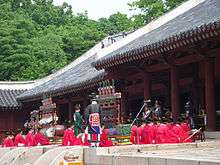Jongmyo
| Jongmyo Shrine | |
|---|---|
| Name as inscribed on the World Heritage List | |
_-_Seoul%2C_Korea.jpg) | |
| Type | Cultural |
| Criteria | iv |
| Reference | 738 |
| UNESCO region | Asia-Pacific |
| Inscription history | |
| Inscription | 1995 (19th Session) |
| Jongmyo | |
| Hangul | 종묘 |
|---|---|
| Hanja | 宗廟 |
| Revised Romanization | Jongmyo |
| McCune–Reischauer | Chongmyo |
Jongmyo is a Confucian shrine dedicated to the perpetuation of memorial services for the deceased kings and queens of the Korean Joseon Dynasty (1392–1897). According to UNESCO, the shrine is the oldest royal Confucian shrine preserved and the ritual ceremonies continue a tradition established in the 14th century. Such shrines existed during the Three Kingdoms of Korea period (57-668), but these have not survived. The Jongmyo Shrine was added to the UNESCO World Heritage list in 1995.
Jongmyo is adjacent to Changdeokgung and Changgyeonggung in the south. They used to be connected in the Joseon period, but were separated by a road built by Japanese colonialists. Nowadays there is a construction plan to recover the original structure of the shrine.
The main buildings of Jongmyo was constructed in October, 1394 when Taejo, first king of Joseon Dynasty, moved the capital to Seoul. It was destroyed by fire in the Japanese invasions of Korea (1592–98), then rebuilt in 1608.
History
When it was built in 1394 by order of King Taejo, the Jongmyo Shrine was thought to be one of the longest buildings in Asia, if not the longest. The main hall, known as Jeongjeon, had seven rooms. Each room was reserved for a king and his queen. The complex was expanded by King Sejong (r. 1418–50) who ordered the construction of Yeongnyeongjeon (Hall of Eternal Comfort). This practice of expansion continued, with the growth of the complex moving from west to east, because of the need to house more memorial tablets during the reigns of later kings until there were a total of 19 rooms. However, during the Seven-Year War (1592–98), Japanese invaders burned down the original shrine and a new complex was constructed in 1601 and has survived to this day. The original tablets were saved in the invasion by hiding them in the house of a commoner and also survive. . A king's tablets were enshrined three years after his death. There are 19 memorial tablets of kings and 30 of their queens, placed in the 19 chambers. Each room is very simple and plain in design. Only two kings' memorial tablets are not enshrined here.. In addition to the tablet, there is a panel listing each king's accomplishments.
The current Jeongjeon is National treasure of Korea No. 227 and is the longest building in Korea of traditional design..
Description
Viewed from the king's throne at Gyeongbokgung Palace, Jongmyo Shrine would have been on the king's left while the Sajik Shrine, another important Confucian shrine, was on the right. This arrangement was derived from Chinese practice. The main halls are surrounded by hills. In front of the main hall is the Woldae Courtyard, which is 150 meters in length and 100 meters in width.
The south entrance gate was reserved for spirits to enter and exit, the east gate was for the king, and the west gate was for the performers of the royal ritual..
The Jongmyo Shrine is divided into 15 main parts.
|
|
Jeong Moon -정문- (Main Gate)
The main entrance to the whole shrine sits here.
Rituals and performances
Jongmyo jeryeak

An elaborate performance of ancient court music (with accompanying dance) known as Jongmyo jeryeak (hangul: 종묘제례악; hanja: 宗廟祭禮樂) is performed there each year for the Jongmyo jerye ritual. Musicians, dancers, and scholars would perform Confucian rituals, such as the Jongmyo Daeje (Royal Shrine Ritual) in the courtyard five times a year. . Today the rituals have been reconstructed and revived. The Jongmyo Daeje has been designated as Important Intangible Cultural Property No. 56 and is performed every year on the first Sunday in May. . The Jongmyo Jerye-ak, the traditional court music of Joseon, is performed by the Royal Court Orchestra and has been designated as Important Intangible Cultural Property of South Korea No. 1.. This court music has its origins in Chinese court music that was brought to Korea during the Goryeo period (918-1392). . King Sejong composed new music for the ritual based largely on hyangak (with some dangak) in 1447 and 1462. .
The songs invite the ancestral spirits to descend from heaven to enjoy the kings achievements in founding the dynasty and defending the country in order to encourage their descendants to follow in their footsteps.[1]
Today the members of the Jeonju Yi Royal Family Association perform the rites to the accompaniment of music and dance provided by musicians from the National Center for Korean Traditional Performing Arts and dancers from the Gukak National High School[1]
Access
Jongmyo entry is located 155 Jong-no, Jongno-gu. The nearest subway station is
- Jongno 3-ga Station (Station #130 on Line 1, Station #329 on Line 3, Station #534 on Line 5).
See also
- Korean Buddhist temples
- National treasures of Korea
- Munmyo
- List of Korea-related topics
- Taimiao, Beijing
- Thế Miếu, Huế
- Triệu Tổ miếu, Huế
| Wikimedia Commons has media related to Jongmyo. |
Bibliography
- Hoon, Shin Young (2008). The Royal Palaces of Korea: Six Centuries of Dynastic Grandeur (Hardback). Singapore: Stallion Press. ISBN 978-981-08-0806-8.
References
External links
- Official website
- UNESCO Jongmyo shrine
- UNESCO Masterpiece of the Oral and Intangible Heritage of Humanity Jongmyo Daeje ceremony
- Jongmyo Jeryeak : Official Seoul City Tourism
- Jongmyo Shrine : Official Site of Korea Tourism Org
- Life in Korea: Jongmyo
- Asian Historical Architecture: Jongmyo
- The Seoul Guide : Jongmyo Shrine
Coordinates: 37°34′29″N 126°59′38″E / 37.57472°N 126.99389°E